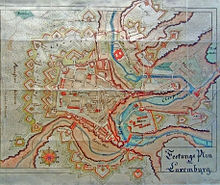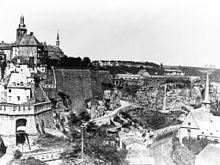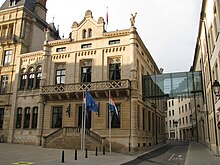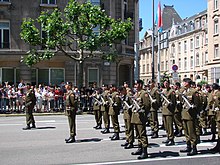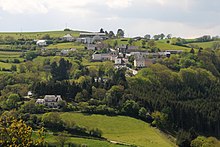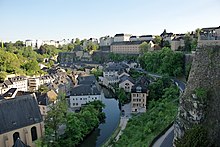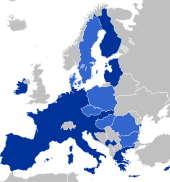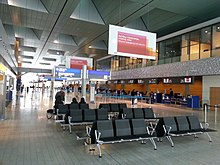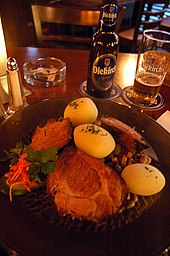Luxembourg
|
Grand Duchy of Luxembourg
|
|
|---|---|
|
Motto:
“Mir wëlle bleiwe wat mir sinn“ (Luxembourgish) “Nous voulons rester ce que nous sommes“ (French) “Wir wollen bleiben, was wir sind“ (German) “We want to remain what we are” |
|
|
|
|
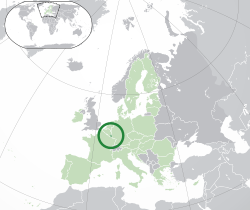
|
|
| Capital
and largest city
|
Luxembourg City 49°48′52″N 06°07′54″ECoordinates: 49°48′52″N 06°07′54″E |
| Official languages | |
| Nationality (2017) |
|
| Demonym(s) | Luxembourg Luxembourger |
| Government | Unitary parliamentary constitutional monarchy |
| Henri | |
|
• Prime Minister (list)
|
Xavier Bettel |
| Legislature | Chamber of Deputies |
| Independence | |
|
• from the French Empire and elevation to Grand Duchy of Luxembourg
|
15 March 1815 |
|
• Independence in personal Union with the Netherlands (Treaty of London)
|
19 April 1839 |
|
• Reaffirmation of Independence Treaty of London
|
11 May 1867 |
|
• End of personal union with the Kingdom of the Netherlands
|
23 November 1890 |
|
• from the German Reich
|
1944 / 1945 |
| 24 October 1945 | |
| 1 January 1958 | |
| Area | |
|
• Total
|
2,586.4 km2 (998.6 sq mi) (167th) |
|
• Water (%)
|
0.60% |
| Population | |
|
• January 2019 estimate
|
|
|
• 2001 census
|
439,539 |
|
• Density
|
233.7/km2 (605.3/sq mi) (58th) |
| GDP (PPP) | 2019 estimate |
|
• Total
|
$70.926 billion[2] (94th) |
|
• Per capita
|
$114,825[2] (2nd) |
| GDP (nominal) | 2019 estimate |
|
• Total
|
$77.436 billion[2] (71st) |
|
• Per capita
|
$125,364[2] (1st) |
| Gini (2018) | medium · 19th |
| HDI (2017) | very high · 21st |
| Currency | Euro (€)b (EUR) |
| Time zone | UTC+1 (CET) |
|
• Summer (DST)
|
UTC+2 (CEST) |
| Note: Although Luxembourg is located in Western European Time/UTC (Z) zone, since 1 June 1904, LMT (UTC+0:24:36) was abandoned and Central European Time/UTC+1 was adopted as standard time,[1] with a +0:35:24 offset (+1:35:24 during DST) from Luxembourg City’s LMT. | |
| Driving side | right |
| Calling code | +352 |
| ISO 3166 code | LU |
| Internet TLD | .luc |
|
|
Luxembourg (/ˈlʌksəmbɜːrɡ/ (![]() listen) LUK-səm-burg;[5] Luxembourgish: Lëtzebuerg [ˈlətsəbuə̯ɕ] (
listen) LUK-səm-burg;[5] Luxembourgish: Lëtzebuerg [ˈlətsəbuə̯ɕ] (![]() listen); French: Luxembourg; German: Luxemburg), officially the Grand Duchy of Luxembourg,[c] is a landlocked microstate in western Europe. It is bordered by Belgium to the west and north, Germany to the east, and France to the south. Its capital, Luxembourg City, is one of the four official capitals of the European Union[6] (together with Brussels, Frankfurt, and Strasbourg) and the seat of the European Court of Justice, the highest judicial authority in the EU. Its culture, people, and languages are highly intertwined with its neighbours, making it essentially a mixture of French and German cultures, as evident by the nation’s three official languages: French, German, and the national language of Luxembourgish. The repeated invasions by Germany, especially in World War II, resulted in the country’s strong will for mediation between France and Germany and, among other things, led to the foundation of the European Union.[7]
listen); French: Luxembourg; German: Luxemburg), officially the Grand Duchy of Luxembourg,[c] is a landlocked microstate in western Europe. It is bordered by Belgium to the west and north, Germany to the east, and France to the south. Its capital, Luxembourg City, is one of the four official capitals of the European Union[6] (together with Brussels, Frankfurt, and Strasbourg) and the seat of the European Court of Justice, the highest judicial authority in the EU. Its culture, people, and languages are highly intertwined with its neighbours, making it essentially a mixture of French and German cultures, as evident by the nation’s three official languages: French, German, and the national language of Luxembourgish. The repeated invasions by Germany, especially in World War II, resulted in the country’s strong will for mediation between France and Germany and, among other things, led to the foundation of the European Union.[7]
With an area of 2,586 square kilometres (998 sq mi), it is one of the smallest sovereign states in Europe.[8] In 2019, Luxembourg had a population of 613,894, which makes it one of the least-populous countries in Europe,[9] but by far the one with the highest population growth rate.[10] Foreigners account for nearly half of Luxembourg’s population.[11] As a representative democracy with a constitutional monarch, it is headed by Grand Duke Henri and is the world’s only remaining sovereign grand duchy. Luxembourg is a developed country, with an advanced economy and one of the world’s highest GDP (PPP) per capita. The City of Luxembourg with its old quarters and fortifications was declared a UNESCO World Heritage Site in 1994 due to the exceptional preservation of the vast fortifications and the old city.[12]
The history of Luxembourg is considered to begin in 963, when count Siegfried acquired a rocky promontory and its Roman-era fortifications known as Lucilinburhuc, “little castle”, and the surrounding area from the Imperial Abbey of St. Maximin in nearby Trier.[13][14] Siegfried’s descendants increased their territory through marriage, war and vassal relations. At the end of the 13th century, the counts of Luxembourg reigned over a considerable territory.[15] In 1308, Henry VII, Count of Luxembourg became King of the Germans and later Holy Roman Emperor. The House of Luxembourg produced four emperors during the High Middle Ages. In 1354, Charles IV elevated the county to the Duchy of Luxembourg. The duchy eventually became part of the Burgundian Circle and then one of the Seventeen Provinces of the Habsburg Netherlands.[16] Over the centuries, the City and Fortress of Luxembourg, of great strategic importance situated between the Kingdom of France and the Habsburg territories, was gradually built up to be one of the most reputed fortifications in Europe. After belonging to both the France of Louis XIV and the Austria of Maria Theresa, Luxembourg became part of the First French Republic and Empire under Napoleon.[17]
The present-day state of Luxembourg first emerged at the Congress of Vienna in 1815. The Grand Duchy, with its powerful fortress, became an independent state under the personal possession of William I of the Netherlands with a Prussian garrison to guard the city against another invasion from France.[18] In 1839, following the turmoil of the Belgian Revolution, the purely French-speaking part of Luxembourg was ceded to Belgium and the Luxembourgish-speaking part (except the Arelerland, the area around Arlon) became what is the present state of Luxembourg.[19]
Luxembourg is a founding member of the European Union, OECD, United Nations, NATO, and Benelux. The city of Luxembourg, which is the country’s capital and largest city, is the seat of several institutions and agencies of the EU. Luxembourg served on the United Nations Security Council for the years 2013 and 2014, which was a first in the country’s history.[20] As of 2018, Luxembourg citizens had visa-free or visa-on-arrival access to 186 countries and territories, ranking the Luxembourgish passport 5th in the world, tied with Austria, the Netherlands, Norway, Portugal, the United Kingdom and the United States.[21]
Contents
History[edit]
Charles IV, the 14th-century Holy Roman Emperor and king of Bohemia from the House of Luxembourg[22]
County[edit]
The recorded history of Luxembourg begins with the acquisition of Lucilinburhuc[23] (today Luxembourg Castle) situated on the Bock rock by Siegfried, Count of Ardennes, in 963 through an exchange act with St. Maximin’s Abbey, Trier.[24] Around this fort, a town gradually developed, which became the centre of a state of great strategic value.
Duchy[edit]
In the 14th and early 15th centuries, three members of the House of Luxembourg reigned as Holy Roman Emperors. In 1437, the House of Luxembourg suffered a succession crisis, precipitated by the lack of a male heir to assume the throne, which led to the territories being sold by Duchess Elisabeth to Philip the Good of Burgundy.[25]
In the following centuries, Luxembourg’s fortress was steadily enlarged and strengthened by its successive occupants, the Bourbons, Habsburgs, Hohenzollerns and the French.
Nineteenth century[edit]
After the defeat of Napoleon in 1815, Luxembourg was disputed between Prussia and the Netherlands. The Congress of Vienna formed Luxembourg as a Grand Duchy within the German Confederation. The Dutch king became, in personal union, the grand duke. Although he was supposed to rule the grand duchy as an independent country with an administration of its own, in reality he treated it similarly to a Dutch province. The Fortress of Luxembourg was manned by Prussian troops for the German Confederation.[26] This arrangement was revised by the 1839 First Treaty of London, from which date Luxembourg’s full independence is reckoned.[27][28][29][30]
At the time of the Belgian Revolution of 1830–1839, and by the 1839 Treaty establishing full independence, Luxembourg’s territory was reduced by more than half, as the predominantly francophone western part of the country was transferred to Belgium. In 1842 Luxembourg joined the German Customs Union (Zollverein).[31] This resulted in the opening of the German market, the development of Luxembourg’s steel industry, and expansion of Luxembourg’s railway network from 1855 to 1875, particularly the construction of the Luxembourg-Thionville railway line, with connections from there to the European industrial regions.[32] While Prussian troops still manned the fortress, in 1861, the Passerelle was opened, the first road bridge spanning the Pétrusse river valley, connecting the Ville Haute and the main fortification on the Bock with Luxembourg railway station, opened in 1859, on the then fortified Bourbon plateau to the south.
After the Luxembourg Crisis of 1866 nearly led to war between Prussia and France, the Grand Duchy’s independence and neutrality were again affirmed by the 1867 Second Treaty of London, Prussia’s troops were withdrawn from the Fortress of Luxembourg, and its Bock and surrounding fortifications were dismantled.[33]
The King of the Netherlands remained Head of State as Grand Duke of Luxembourg, maintaining a personal union between the two countries until 1890. At the death of William III, the throne of the Netherlands passed to his daughter Wilhelmina, while Luxembourg (then restricted to male heirs by the Nassau Family Pact) passed to Adolph of Nassau-Weilburg.[34]
At the time of the Franco-Prussian war in 1870, despite allegations about French use of the Luxembourg railways for passing soldiers from Metz (then part of France) through the Duchy, and for forwarding provisions to Thionville, Luxembourg’s neutrality was respected by Germany, and neither France nor Germany invaded the country.[35][36] But in 1871, as a result of Germany’s victory over France, Luxembourg’s boundary with Lorraine, containing Metz and Thionville, changed from being a frontier with a part of France to a frontier with territory annexed to the German Empire as Alsace-Lorraine under the Treaty of Frankfurt. This allowed Germany the military advantage of controlling and expanding the railways there.
Twentieth century and beyond[edit]
In August 1914, Imperial Germany violated Luxembourg’s neutrality in the war by invading it in the war against France. This allowed Germany to use the railway lines, while at the same time denying them to France. Nevertheless, despite the German occupation, Luxembourg was allowed to maintain much of its independence and political mechanisms.
In 1940, after the outbreak of World War II, Luxembourg’s neutrality was again violated when the Wehrmacht of Nazi Germany entered the country, “entirely without justification”.[37] In contrast to the First World War, under the German occupation of Luxembourg during World War II, the country was treated as German territory and informally annexed to the adjacent province of the Third Reich. A government in exile based in London supported the Allies, sending a small group of volunteers who participated in the Normandy invasion. Luxembourg was liberated in September 1944, and became a founding member of the United Nations in 1945. Luxembourg’s neutral status under the constitution formally ended in 1948, and in 1949 it became a founding member of NATO.
In 1951, Luxembourg became one of the six founding countries of the European Coal and Steel Community, which in 1957 would become the European Economic Community and in 1993 the European Union. In 1999 Luxembourg joined the Eurozone. In 2005, a referendum on the EU treaty establishing a constitution for Europe was held.[38]
The steel industry exploiting the Red Lands‘ rich iron-ore grounds in the beginning of the 20th century drove the country’s industrialisation. After the decline of the steel industry in the 1970s, the country focused on establishing itself as a global financial centre and developed into the banking hub it is reputed for. Since the beginning of the 21st century, its governments have focused on developing the country into a knowledge economy, with the founding of the University of Luxembourg and a national space programme, projecting the first involvement in a robotic lunar expedition by 2020.[39]
Politics[edit]
The Grand Ducal Palace in Luxembourg City, the official residence of the Grand Duke of Luxembourg
The Hall of the Chamber of Deputies, the meeting place of the Luxembourgish national legislature, the Chamber of Deputies, in Luxembourg City
Prime Minister Jean-Claude Juncker and Deputy Prime Minister Jean Asselborn with Russian President Vladimir Putin on 24 May 2007
Luxembourg is described as a “full democracy“,[40] with a parliamentary democracy headed by a constitutional monarch. Executive power is exercised by the Grand Duke and the cabinet, which consists of several other ministers.[41] The Constitution of Luxembourg, the supreme law of Luxembourg, was adopted on 17 October 1868.[42] The Grand Duke has the power to dissolve the legislature, in which case new elections must be held within three months. However, since 1919, sovereignty has resided with the Nation, exercised by the Grand Duke in accordance with the Constitution and the law.[43]
Legislative power is vested in the Chamber of Deputies, a unicameral legislature of sixty members, who are directly elected to five-year terms from four constituencies. A second body, the Council of State (Conseil d’État), composed of twenty-one ordinary citizens appointed by the Grand Duke, advises the Chamber of Deputies in the drafting of legislation.[44]
The Grand Duchy has three lower tribunals (justices de paix; in Esch-sur-Alzette, the city of Luxembourg, and Diekirch), two district tribunals (Luxembourg and Diekirch), and a Superior Court of Justice (Luxembourg), which includes the Court of Appeal and the Court of Cassation. There is also an Administrative Tribunal and an Administrative Court, as well as a Constitutional Court, all of which are located in the capital.
Administrative divisions[edit]
Luxembourg is divided into 12 cantons, which are further divided into 102 communes.[45] Twelve of the communes have city status; the city of Luxembourg is the largest.
Capellen (1) – Clervaux(2) – Diekirch(3) – Echternach(4) – Esch-sur-Alzette(5) – Grevenmacher(6) – Luxembourg(7) – Mersch(8) – Redange(9) – Remich(10) – Vianden(11) – Wiltz(12)
Foreign relations[edit]
The European Court of Justice, seated in Luxembourg City.
Luxembourg has long been a prominent supporter of European political and economic integration. In efforts foreshadowing European integration, Luxembourg and Belgium in 1921 formed the Belgium–Luxembourg Economic Union (BLEU) to create a regime of inter-exchangeable currency and a common customs. Luxembourg is a member of the Benelux Economic Union and was one of the founding members of the European Economic Community (now the European Union). It also participates in the Schengen Group (named after the Luxembourg village of Schengen where the agreements were signed), whose goal is the free movement of citizens among member states. At the same time, the majority of Luxembourgers have consistently believed that European unity makes sense only in the context of a dynamic transatlantic relationship, and thus have traditionally pursued a pro-NATO, pro-US foreign policy.[citation needed]
Luxembourg is the site of the European Court of Justice, the European Court of Auditors, the Statistical Office of the European Communities (“Eurostat“) and other vital EU organs. The Secretariat of the European Parliament is located in Luxembourg, but the Parliament usually meets in Brussels and sometimes in Strasbourg.
Military[edit]
The Army is situated on the “Härebierg” which is Luxemburgish and translates to “men’s mountain”.[46] The army is under civilian control, with the Grand Duke as Commander-in-Chief. The Minister for Defence, currently François Bausch, oversees army operations. The professional head of the army is the Chief of Defence, who answers to the minister and holds the rank of general.
Being a landlocked country, it has no navy. Luxembourg also lacks an air force, though the 17 NATO AWACS aeroplanes are, for convenience, registered as aircraft of Luxembourg.[47] In accordance with a joint agreement with Belgium, both countries have put forth funding for one A400M military cargo plane.[48]
Luxembourg has participated in the Eurocorps, has contributed troops to the UNPROFOR and IFOR missions in former Yugoslavia, and has participated with a small contingent in the current NATO SFOR mission in Bosnia and Herzegovina. Luxembourg troops have also deployed to Afghanistan, to support ISAF. The army has also participated in humanitarian relief missions such as setting up refugee camps for Kurds and providing emergency supplies to Albania.[49]
Geography[edit]
Luxembourg is one of the smallest countries in Europe, and ranked 167th in size of all the 194 independent countries of the world; the country is about 2,586 square kilometres (998 sq mi) in size, and measures 82 km (51 mi) long and 57 km (35 mi) wide. It lies between latitudes 49° and 51° N, and longitudes 5° and 7° E.[50]
The largest towns are Luxembourg, Esch-sur-Alzette, Dudelange, and Differdange.
Typical Luxembourg countryside near Alscheid
To the east, Luxembourg borders the German Bundesländer of Rhineland-Palatinate and Saarland, and to the south, it borders the French région of Grand Est (Lorraine). The Grand Duchy borders the Belgian Walloon Region, in particular the latter’s provinces of Luxembourg and Liège, part of which comprises the German-speaking Community of Belgium, to the west and to the north, respectively.
The northern third of the country is known as the ‘Oesling‘, and forms part of the Ardennes. It is dominated by hills and low mountains, including the Kneiff near Wilwerdange,[51] which is the highest point, at 560 metres (1,837 ft). Other mountains are the ‘Buurgplaaz‘ at 559 metres near Huldange and the ‘Napoléonsgaard‘ at 554 metres near Rambrouch. The region is sparsely populated, with only one town (Wiltz) with a population of more than four thousand people.
The southern two-thirds of the country is called the “Gutland“, and is more densely populated than the Oesling. It is also more diverse and can be divided into five geographic sub-regions. The Luxembourg plateau, in south-central Luxembourg, is a large, flat, sandstone formation, and the site of the city of Luxembourg. Little Switzerland, in the east of Luxembourg, has craggy terrain and thick forests. The Moselle valley is the lowest-lying region, running along the southeastern border. The Red Lands, in the far south and southwest, are Luxembourg’s industrial heartland and home to many of Luxembourg’s largest towns.
The border between Luxembourg and Germany is formed by three rivers: the Moselle, the Sauer, and the Our. Other major rivers are the Alzette, the Attert, the Clerve, and the Wiltz. The valleys of the mid-Sauer and Attert form the border between the Gutland and the Oesling.
According to the 2012 Environmental Performance Index, Luxembourg is one of the world’s best performers in environmental protection, ranking 4th out of 132 assessed countries[52] Luxembourg also ranks 6th among the top ten most livable cities in the world by Mercer’s.[53]
Luxembourg has an oceanic climate (Köppen: Cfb), marked by high precipitation, particularly in late summer. The summers are warm and winters cool.[54]
Economy[edit]
Luxembourg is part of the Schengen Area, the EU single market, and the Eurozone (dark blue)
Luxembourg’s stable and high-income market economy features moderate growth, low inflation, and a high level of innovation.[55] Unemployment is traditionally low, although it had risen to 6.1% by May 2012, due largely to the effect of the 2008 global financial crisis.[56] In 2011, according to the IMF, Luxembourg was the second richest country in the world, with a per capita GDP on a purchasing-power parity (PPP) basis of $80,119.[57] Luxembourg is ranked 13th in The Heritage Foundation‘s Index of Economic Freedom,[58] 26th in the United Nations Human Development Index, and 4th in the Economist Intelligence Unit’s quality of life index.[59]
The industrial sector, which was dominated by steel until the 1960s, has since diversified to include chemicals, rubber, and other products. During the past decades, growth in the financial sector has more than compensated for the decline in steel production. Services, especially banking and finance, account for the majority of economic output. Luxembourg is the world’s second largest investment fund centre (after the United States), the most important private banking centre in the Eurozone and Europe’s leading centre for reinsurance companies. Moreover, the Luxembourg government has aimed to attract Internet start-ups, with Skype and Amazon being two of the many Internet companies that have shifted their regional headquarters to Luxembourg. Other high-tech companies have established themselves in Luxembourg, including 3D scanner developer/manufacturer Artec 3D.
In April 2009, concern about Luxembourg’s banking secrecy laws, as well as its reputation as a tax haven, led to its being added to a “grey list” of nations with questionable banking arrangements by the G20. In response, the country soon after adopted OECD standards on exchange of information and was subsequently added into the category of “jurisdictions that have substantially implemented the internationally agreed tax standard”.[60][61] In March 2010, the Sunday Telegraph reported that most of Kim Jong-Il’s $4 billion in secret accounts is in Luxembourg banks.[62] Amazon.co.uk also benefits from Luxembourg tax loopholes by channeling substantial UK revenues as reported by The Guardian in April 2012.[63] Luxembourg ranked third on the Tax Justice Network‘s 2011 Financial Secrecy Index of the world’s major tax havens, scoring only slightly behind the Cayman Islands.[64] In 2013, Luxembourg is ranked as the 2nd safest tax haven in the world, behind Switzerland.
In early November 2014, just days after becoming head of the European Commission, the former Luxembourg’s Prime Minister Jean-Claude Juncker was hit by media disclosures—derived from a document leak known as Luxembourg Leaks—that Luxembourg under his premiership had turned into a major European centre of corporate tax avoidance.[65]
Agriculture employed about 2.1% percent of Luxembourg’s active population in 2010, when there were 2200 agricultural holdings with an average area per holding of 60 hectares.[66]
Luxembourg has especially close trade and financial ties to Belgium and the Netherlands (see Benelux), and as a member of the EU it enjoys the advantages of the open European market.
With $171 billion in May 2015, the country ranks eleventh in the world in holdings of U.S. Treasury securities.[67] However, securities owned by non-Luxembourg residents, but held in custodial accounts in Luxembourg, are also included in this figure.[68]
As of 2018, public debt of Luxembourg was at $14,865,000,000, or a per capita debt of $24,683. The debt to GDP was 21,40%.[69]
Transport[edit]
Luxembourg’s international airline Luxair is based at Luxembourg Airport, the country’s only international airport.
Luxembourg has efficient road, rail and air transport facilities and services. The road network has been significantly modernised in recent years with 147 km (91 mi) of motorways connecting the capital to adjacent countries. The advent of the high-speed TGV link to Paris has led to renovation of the city’s railway station and a new passenger terminal at Luxembourg Airport was opened in 2008. Luxembourg city reintroduced trams in December 2017 and there are plans to open light-rail lines in adjacent areas within the next few years.
The number of cars per 1000 persons amount to 680.1 in Luxembourg — higher than all but two states, namely the Principality of Monaco and the British overseas territory of Gibraltar.[70]
In 2019, it is set to become the first country to make public transportation free.[71]
Communications[edit]
The telecommunications industry in Luxembourg is liberalised and the electronic communications networks are significantly developed. Competition between the different operators is guaranteed by the legislative framework Paquet Telecom[72] of the Government of 2011 which transposes the European Telecom Directives into Luxembourgish law. This encourages the investment in networks and services. The regulator ILR – Institut Luxembourgeois de Régulation[73] ensures the compliance to these legal rules.
Luxembourg has modern and widely deployed optical fiber and cable networks throughout the country. In 2010, the Luxembourg Government launched its National strategy for very high-speed networks with the aim to become a global leader in terms of very high-speed broadband by achieving full 1 Gbit/s coverage of the country by 2020.[74] In 2011, Luxembourg had an NGA coverage of 75%.[75] In April 2013 Luxembourg featured the 6th highest download speed worldwide and the 2nd highest in Europe: 32,46 Mbit/s.[76] The country’s location in Central Europe, stable economy and low taxes favour the telecommunication industry.[77][78][79]
It ranks 2nd in the world in the development of the Information and Communication Technologies in the ITU ICT Development Index and 8th in the Global Broadband Quality Study 2009 by the University of Oxford and the University of Oviedo.[80][81][82][83]
Signs in front of the Centre Drosbach on the Cloche d’or, in the city of Luxembourg
Luxembourg is connected to all major European Internet Exchanges (AMS-IX Amsterdam,[84] DE-CIX Frankfurt,[85] LINX London),[86] datacenters and POPs through redundant optical networks.[87][88][89][90][91] In addition, the country is connected to the virtual meetme room services (vmmr)[92] of the international data hub operator Ancotel.[93] This enables Luxembourg to interconnect with all major telecommunication operators[94] and data carriers worldwide. The interconnection points are in Frankfurt, London, New York and Hong Kong.[95] Luxembourg has established itself as one of the leading financial technology (FinTech) hubs in Europe, with the Luxembourg government supporting initiatives like the Luxembourg House of Financial Technology.[96]
Some 20 data centres[97][98][99] are operating in Luxembourg. Six data centers are Tier IV Design certified: three of ebrc,[100] two of LuxConnect [101][102] and one of European Data Hub.[103] In a survey on nine international data centers carried out in December 2012 and January 2013 and measuring availability (up-time) and performance (delay by which the data from the requested website was received), the top three positions were held by Luxembourg data centers.[104][105]
Demographics[edit]
Largest towns[edit]
|
Largest cities or towns in Luxembourg 2005
|
|||||||||
|---|---|---|---|---|---|---|---|---|---|
| Rank | Name | District | Pop. | ||||||
 Luxembourg (city)  Esch-sur-Alzette |
1 | Luxembourg (city) | Luxembourg District | 76,420 |  Differdange  Dudelange |
||||
| 2 | Esch-sur-Alzette | Luxembourg District | 28,000 | ||||||
| 3 | Differdange | Luxembourg District | 19,005 | ||||||
| 4 | Dudelange | Luxembourg District | 17,618 | ||||||
| 5 | Ettelbruck | Diekirch District | 7,364 | ||||||
| 6 | Diekirch | Diekirch District | 6,165 | ||||||
| 7 | Wiltz | Diekirch District | 4,587 | ||||||
| 8 | Echternach | Grevenmacher District | 4,507 | ||||||
| 9 | Rumelange | Luxembourg District | 4,495 | ||||||
| 10 | Grevenmacher | Grevenmacher District | 3,966 | ||||||
Ethnicity[edit]
|
The people of Luxembourg are called Luxembourgers.[107] The immigrant population increased in the 20th century due to the arrival of immigrants from Belgium, France, Italy, Germany, and Portugal, with the majority coming from the latter: in 2013 there were about 88,000 inhabitants with Portuguese nationality.[108] In 2013, there were 537,039 permanent residents, 44.5% of which were of foreign background or foreign nationals; the largest foreign ethnic groups were the Portuguese, comprising 16.4% of the total population, followed by the French (6.6%), Italians (3.4%), Belgians (3.3%) and Germans (2.3%). Another 6.4% were of other EU background, while the remaining 6.1% were of other non-EU, but largely other European, background.[109]
Since the beginning of the Yugoslav wars, Luxembourg has seen many immigrants from Bosnia and Herzegovina, Montenegro, and Serbia. Annually, over 10,000 new immigrants arrive in Luxembourg, mostly from the EU states, as well as Eastern Europe. In 2000 there were 162,000 immigrants in Luxembourg, accounting for 37% of the total population. There were an estimated 5,000 illegal immigrants in Luxembourg in 1999.[110]
Language[edit]
Coin of the former Luxembourg franc in two of the country’s three languages: French (obverse, left) and Luxembourgish (reverse, right)
The linguistic situation of Luxembourg is complex. It is characterized by the existence of a language specific to the local population (Luxembourgish), mixed with the historical presence of the two major languages spoken in the surrounding countries (French and German).
Three languages are recognised as official in Luxembourg: French, German, and Luxembourgish, a Franconian language of the Moselle region that is also spoken in neighbouring parts of Belgium, Germany and France. Though Luxembourgish is part of the West Central German group of High German languages, more than 5,000 words in the language are of French origin.[111][112] The first printed sentences in Luxembourgish appeared in a weekly journal, the Luxemburger Wochenblatt, in the second edition on 14 April 1821.
Apart from being one of the three official languages, Luxembourgish is also considered the national language of the Grand Duchy; it is the mother tongue or “language of the heart” for the local population.[113]
Every citizen or resident has the right to address the administration in the language of their choice among the three official languages and to be answered in that language.
Due to the historical influence of the Napoleonic Code on the legal system of the Grand Duchy, French is the sole language of the legislation. French is generally the preferred language of the government, administration and justice. The parliamentary debates are however mostly conducted in Luxembourgish, whereas the written government communications and the official documents (e.g. administrative or judicial decisions, passports etc.) are drafted only in French.
Each of the three languages is used as the primary language in certain spheres of everyday life, without being exclusive. Luxembourgish is the language that Luxembourgers generally use to speak to each other, but it is not often used as the written language and the numerous expatriate workers (approximately 60% of the population) generally do not use it to speak to each other. Since the 1980s, however, an increasing number of novels have been written in Luxembourgish. Most official business is carried out in French. German is very often used in much of the media alongside with French.[114] French is mostly used for written communications from the authorities to the public.
A 2009 survey pointed out that French was the language spoken by most inhabitants (99%), followed by Luxembourgish (82%), German (81%), and English (72%).[115]
Although professional life is largely multilingual, French is described by private sector business leaders as the main working language of their companies (56%), followed by Luxembourgish (20%), English (18%), and German (6%).[116]
Due to the large community of Portuguese origin, the Portuguese language is de facto fairly present in Luxembourg though it remains limited to the relationships inside this community; although Portuguese does not have any official status, the administration sometimes holds certain informative documents available in Portuguese.
Religion[edit]
Notre-Dame Cathedral, Luxembourg City
Luxembourg is a secular state, but the state recognises certain religions as officially mandated religions. This gives the state a hand in religious administration and appointment of clergy, in exchange for which the state pays certain running costs and wages. Currently, religions covered by such arrangements are Roman Catholicism, Judaism, Greek Orthodoxy, Anglicanism, Russian Orthodoxy, Lutheranism, Calvinism, Mennonitism, and Islam.[117]
Since 1980 it has been illegal for the government to collect statistics on religious beliefs or practices.[118] An estimation by the CIA Factbook for the year 2000 is that 87% of Luxembourgers are Catholic, including the grand ducal family, the remaining 13% being made up of Protestants, Orthodox Christians, Jews, Muslims, and those of other or no religion.[119] According to a 2010 Pew Research Center study, 70.4% are Christian, 2.3% Muslim, 26.8% unaffiliated, and 0.5% other religions.[120]
According to a 2005 Eurobarometer poll,[121] 44% of Luxembourg citizens responded that “they believe there is a God”, whereas 28% answered that “they believe there is some sort of spirit or life force”, and 22% that “they do not believe there is any sort of spirit, god, or life force”.
Education[edit]
The University of Luxembourg is the only university based in the country.
Luxembourg’s education system is trilingual: the first years of primary school are in Luxembourgish, before changing to German; while in secondary school, the language of instruction changes to French.[122] Proficiency in all three languages is required for graduation from secondary school, but half the students leave school without a certified qualification, with the children of immigrants being particularly disadvantaged.[123] In addition to the three national languages, English is taught in compulsory schooling and much of the population of Luxembourg can speak English. The past two decades have highlighted the growing importance of English in several sectors, in particular the financial sector. Portuguese, the language of the largest immigrant community, is also spoken by large segments of the population, but by relatively few from outside the Portuguese-speaking community.[124]
The University of Luxembourg is the only university based in Luxembourg. In 2014, Luxembourg School of Business, a graduate business school, has been created through private initiative and has received the accreditation from the Ministry of Higher Education and Research of Luxembourg in 2017.[125][126] Two American universities maintain satellite campuses in the country, Miami University (Dolibois European Center) and Sacred Heart University (Luxembourg Campus).[127]
Health[edit]
According to data from the World Health Organization, healthcare spending on behalf of the government of Luxembourg topped $4.1 Billion, amounting to about $8,182 for each citizen in the nation.[128][129] The nation of Luxembourg collectively spent nearly 7% of its Gross Domestic Product on health, placing it among the highest spending countries on health services and related programs in 2010 among other well-off nations in Europe with high average income among its population.[130]
Culture[edit]
Edward Steichen, photographer and painter
Luxembourg has been overshadowed by the culture of its neighbours. It retains a number of folk traditions, having been for much of its history a profoundly rural country. There are several notable museums, located mostly in the capital. These include the National Museum of History and Art (NMHA), the Luxembourg City History Museum, and the new Grand Duke Jean Museum of Modern Art (Mudam). The National Museum of Military History (MNHM) in Diekirch is especially known for its representations of the Battle of the Bulge. The city of Luxembourg itself is on the UNESCO World Heritage List, on account of the historical importance of its fortifications.[131]
The country has produced some internationally known artists, including the painters Théo Kerg, Joseph Kutter and Michel Majerus, and photographer Edward Steichen, whose The Family of Man exhibition has been placed on UNESCO’s Memory of the World register, and is now permanently housed in Clervaux. Movie star Loretta Young was of Luxembourgish descent.
Luxembourg was the first city to be named European Capital of Culture twice. The first time was in 1995. In 2007, the European Capital of Culture[132] was to be a cross-border area consisting of the Grand Duchy of Luxembourg, the Rheinland-Pfalz and Saarland in Germany, the Walloon Region and the German-speaking part of Belgium, and the Lorraine area in France. The event was an attempt to promote mobility and the exchange of ideas, crossing borders physically, psychologically, artistically and emotionally.
Luxembourg was represented at the World Expo 2010 in Shanghai, China, from 1 May to 31 October 2010 with its own pavilion.[133][134] The pavilion was based on the transliteration of the word Luxembourg into Chinese, “Lu Sen Bao”, which means “Forest and Fortress”. It represented Luxembourg as the “Green Heart in Europe”.[135]
Sports[edit]
Charly Gaul won three Grand Tours in his cycling career.
Unlike most countries in Europe, sport in Luxembourg is not concentrated upon a particular national sport, but encompasses a number of sports, both team and individual. Despite the lack of a central sporting focus, over 100,000 people in Luxembourg, out of a total population of near 500,000–600,000, are licensed members of one sports federation or another.[136] The largest sports venue in the country is d’Coque, an indoor arena and Olympic swimming pool in Kirchberg, north-eastern Luxembourg City, which has a capacity of 8,300. The arena is used for basketball, handball, gymnastics, and volleyball, including the final of the 2007 Women’s European Volleyball Championship. The national stadium (also the country’s largest) is the Stade Josy Barthel, in western Luxembourg City; named after the country’s only official Olympic gold medallist, the stadium has a capacity of 8,054.
Cuisine[edit]
Judd mat Gaardebounen, served with boiled potatoes and Diekirch beer
Luxembourg cuisine reflects its position on the border between the Latin and Germanic worlds, being heavily influenced by the cuisines of neighboring France and Germany. More recently, it has been enriched by its many Italian and Portuguese immigrants.
Most native Luxembourg dishes, consumed as the traditional daily fare, share roots in the country’s folk dishes the same as in neighboring Germany.
Luxembourg sells the most alcohol in Europe per capita.[137] However, the large proportion of alcohol purchased by customers from neighboring countries contributes to the statistically high level of alcohol sales per capita; this level of alcohol sales is thus not representative of the actual alcohol consumption of the Luxembourg population.[138]
Media[edit]
The main languages of media in Luxembourg are French and German. The newspaper with the largest circulation is the German-language daily Luxemburger Wort.[139] Because of the strong multilingualism in Luxembourg, newspapers often alternate articles in French and articles in German, without translation. In addition there are both English and Portuguese radio and national print publications, but accurate audience figures are difficult to gauge since the national media survey by ILRES [140] is conducted in French.
Luxembourg is known in Europe for its radio and television stations (Radio Luxembourg and RTL Group). It is also the uplink home of SES, carrier of major European satellite services for Germany and Britain.
Due to a 1988 law that established a special tax scheme for audiovisual investment, the film and co-production in Luxembourg has grown steadily.[141] There are some 30 registered production companies in Luxembourg.[142][143]
Luxembourg won an Oscar in 2014 in the Animated Short Films category with Mr Hublot.




